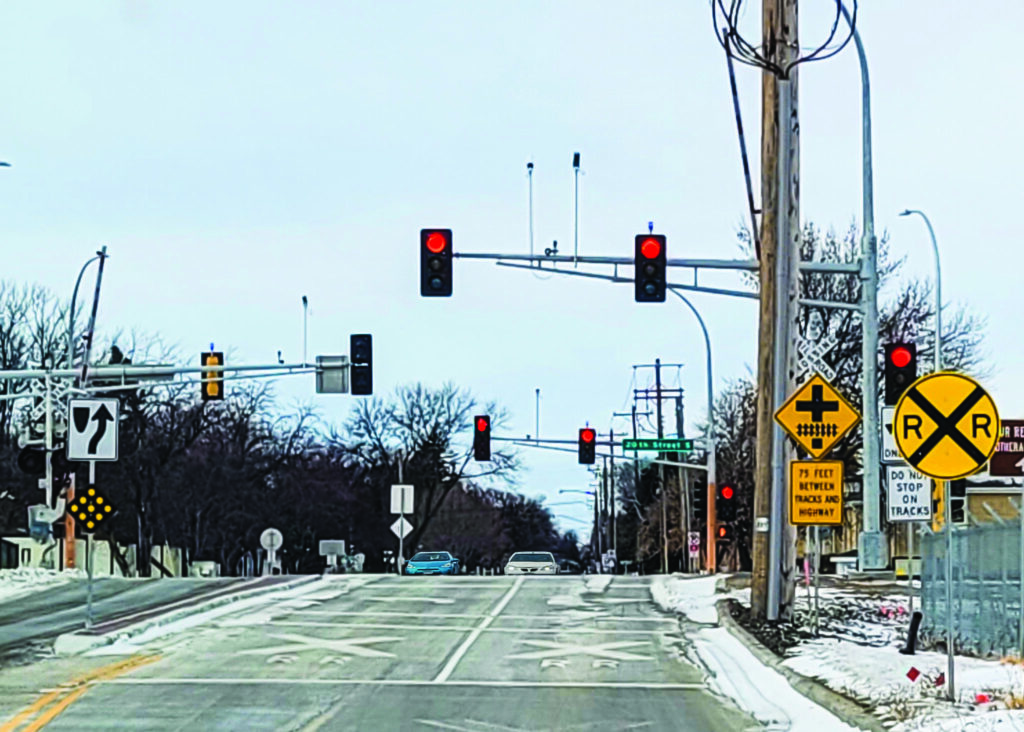
Twelfth Avenue South is now open all the way from Fourth Street to Highway 52. The new pre-signal east of the railroad tracks on 12th is intended to prevent vehicles from being caught on the BNSF tracks when a train is coming. (Photo/Nancy Hanson.)
If you’re traveling west on the newly completed 12th Avenue South, you’ll be seeing red — a little more red — when you come to the railroad tracks.
Moorhead has installed the region’s first “pre-signal” on the east edge of the bank of three BNSF rails that parallels 20th Street South. It’s a safety measure to keep the three sets of tracks clear when a train approaches — an addition to prevent vehicles from being caught between cross-arms as a locomotive bears down on them.
The pre-signal is a full stop light — red, yellow and green — that anticipates the changing colors on the signals at the cross-street intersection about 100 feet further west. It’s easy for drivers familiar with the avenue to overlook it, especially when its colors match those on the upcoming corner. Don’t! Overlooking or ignoring a red on the pre-signal is just as much a legal infraction as slipping through any other.
Installation of the pre-signal, says city traffic engineer Jonathan Atkins, is one of the finishing projects on the drawn-out reconstruction of 12th Avenue South from Fourth Street to Southeast Main Avenue (Highway 52). The first leg of the route, from Fourth to the tracks, was completed in 2020. The eastern end, from the tracks to the highway, was rebuilt in 2021.
The last link in renewing the heavily traveled avenue was closed this summer, when the BNSF Railway turned its attention to its tracks and the concrete plates that make up the crossing surface. Not until those were restored early this fall could the city pour the final concrete up to the plates’ edges.
At the same time, crews completed the 10-foot-wide shared-use pathway along the south edge of 12th. Now, Atkins points out, bicyclists and pedestrians can safely make their way through the busy intersection.
The 12th Avenue-20th Street intersection currently sees12,908 vehicles per day, including most of the city’s school buses traveling to and from the middle and high schools, MAT buses and semis bound for the industrial park to the south and east.
The pre-signal — first of its kind in the region — is required by new safety standards set by the Federal Railroad Administration and required by BNSF. At the same time, the railroad has removed the easternmost pair of what had long been a gauntlet of five parallel tracks.
Atkins notes that those heading east and west across the tracks will notice another big improvement, to comfort if not always to safety: The bumpity-bumpity ride bouncing over the tracks has been smoothed out by adjusting the pitch of the roadway.
That’s even better news for heavy vehicles like buses and trucks, particularly during the season of ice and snow. “Heavily loaded semis and, especially, buses have sometimes had a rough time getting over the steeply pitched track beds,” he explains. “Especially buses — they have to stop, open the doors to listen, and then get going again. If conditions are slippery, that could be a problem. In the past, we’ve had to go out and help them get going.” The reconstruction should eliminate that problem.
The pre-signal works just like any of Moorhead’s other 50 traffic signals, 22 of which involve railroad crossings. The biggest challenge may be that those who regularly drive that route may not notice the additional signal at first on their next trips heading west. (It only affects those about to cross the tracks from the east.)
“It’s a matter of getting used to it. Just look up before you get all the way to the intersection instead of focusing only on the lights down at the corner,” Atkins advises. “Red means stop. Green means go. Pretty simple, really.”


